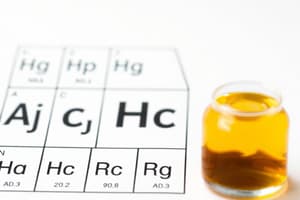Podcast
Questions and Answers
What is the primary purpose of chemical symbols and formulae?
What is the primary purpose of chemical symbols and formulae?
To represent individual elements and describe how atoms combine to make molecules.
How are atoms typically represented in chemical symbols?
How are atoms typically represented in chemical symbols?
By one or two capital letters.
What does CO2 represent in chemistry?
What does CO2 represent in chemistry?
Carbon dioxide.
What type of compounds involve sharing electrons between nonmetal atoms?
What type of compounds involve sharing electrons between nonmetal atoms?
What type of bonds are formed in covalent compounds?
What type of bonds are formed in covalent compounds?
What is the key requirement for all covalent compounds?
What is the key requirement for all covalent compounds?
Why is it important to balance chemical equations?
Why is it important to balance chemical equations?
How do ions achieve neutrality in a balanced equation?
How do ions achieve neutrality in a balanced equation?
What is the significance of understanding electron transfers in chemistry?
What is the significance of understanding electron transfers in chemistry?
Why is mastery of symbols and formulas essential in chemistry?
Why is mastery of symbols and formulas essential in chemistry?
Flashcards are hidden until you start studying
Study Notes
Language of Chemistry
Chemists use special terms and abbreviations to communicate ideas and concepts effectively within their field. This specialized vocabulary is known as the language of chemistry. Let's explore some key components of this language, including symbols and formulas, covalent compounds, and balancing chemical equations.
Symbols and Formulas
The primary building blocks of chemistry communication are chemical symbols and formulae. These symbols represent individual elements, while formulae describe how atoms combine to make molecules. For example, H stands for hydrogen, O for oxygen, and CO2 represents carbon dioxide. Atoms are represented by one or two capital letters, while the atomic number appears below the symbol. In ionic compounds, charges can also appear next to element symbols to indicate positive or negative charges.
Formulae have several variations based on context: empirical formulae show only the simplest whole number ratio of atoms; molecular formulae specify actual numbers of each atom type; structural formulae illustrate the bonding arrangement between atoms; and condensed structures combine features of these other formats into a single diagram.
Covalent Compounds
A particular class of bonds involves sharing electrons instead of giving them away, forming what scientists call covalent bonds. When two nonmetal atoms share electrons with one another, they form a covalent compound. An important feature of all covalent compounds is that they must contain equal or nearly equal amounts of each element involved in the compound.
Balancing Equations
Balanced chemical equations convey information about reactants and products, showing both physical states and relative concentrations. They ensure conservation laws like mass and energy are upheld. To achieve neutrality, all free charges from ions must cancel out before the equation is balanced. Ions carry either a plus or minus charge. If you think of valence electrons being transferred from left to right, then the sum of the charges on both sides equals zero when you multiply any quantity by its opposite sign.
Understanding the importance of electron transfers and charges helps chemists interpret complex reactions more accurately. By using the correct notation and understanding electron transfer patterns, researchers can precisely predict the behavior of many metals under various conditions.
In conclusion, mastery of the language of chemistry includes familiarity with fundamental constructs such as symbols and formulae, knowledge of covalent compounds, and proficiency in writing balanced equations. Just like learning a new language, it takes practice and patience to become fluent in this technical lingo.
Studying That Suits You
Use AI to generate personalized quizzes and flashcards to suit your learning preferences.




